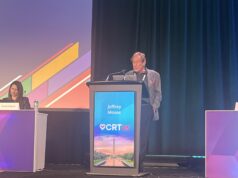
A timing substudy of the COMPLETE trial has found that, compared with culprit-lesion only percutaneous coronary intervention (PCI), a strategy of non-culprit lesion PCI with the goal of complete revascularisation performed early during index hospitalisation (median one day) or after discharge (median 23 days) confers similar benefit on major cardiovascular events.
David Wood (University of British Columbia, Vancouver, Canada) presented the data at a late-breaking trial session at Transcatheter Cardiovascular Therapeutics scientific symposium (TCT 2019; 25–29 September, San Francisco, USA). Importantly, he said: “The benefit of complete revascularisation on hard outcomes (cardiovascular death or myocardial infarction) emerges mainly over the long term [>45 days], which we truly believe is a paradigm shift.”
The substudy also found that there were no statistically significant differences in safety outcomes between randomly allocated therapy (complete versus culprit lesion only PCI) either during the index hospitalisation or after discharge.
Findings from the global COMPLETE study were presented by Shamir R Mehta (Population Health Research Institute, Hamilton, California, USA) at the European Society of Cardiology Congress (ESC 2019; 31 August–4 September, Paris France) and simultaneously published in the New England Journal of Medicine. It noted that a strategy of complete revascularisation was superior to culprit lesion-only PCI in reducing the risk of cardiovascular death or myocardial infarction (MI) in patients with ST-segment myocardial infarction (STEMI) and multivessel coronary artery disease. The timing of PCI for the non-culprit lesions had no significant impact on outcomes observed, and the main driver of the decreased risk was a reduction in the rates of type 1 myocardial infarction.
COMPLETE was a randomised, comparative effectiveness study of complete versus culprit-only revascularisation strategies to treat multivessel disease after early percutaneous coronary intervention for ST-segment elevation myocardial infarction, in which researchers randomly assigned (1:1) patients with STEMI and multivessel coronary artery disease who had undergone successful culprit lesion only PCI to a strategy of either complete revascularisation with PCI of angiographically significant nonculprit lesions (2,016) or to no further revascularisation (2,025). Randomisation was stratified according to the timing of the nonculprit lesion PCI. This was performed either during the index hospitalisation, or after discharge from hospital (no later than 45 days after randomisation), a decision that was taken before participants were randomised. Median follow up was three years, with the longest follow up at five years.
The coprimary outcomes included a composite of CV death or new MI or a composite of CV death, new MI or ischaemia driven revascularisation. Key secondary outcomes also included unstable angina and heart failure. On the coprimary outcome of a composite of CV death or new MI for complete revascularisation versus culprit lesion only, the hazard ratio (HR) was 0.76 (95% confidence interval [CI] 0.6–0.91, p=0.004, number needed to treat [NNT] over a median of three years 37). The second coprimary outcome yielded a HR of 0.51 (95% CI 0.43–0.61, p<0.001, NNT 13).
Wood explained: “The objectives of the key timing substudy were to determine if there is a difference in the benefit of a strategy of complete revascularisation versus culprit-lesion-only PCI according to the intended timing of non-culprit PCI, either during the index hospitalisation or after discharge. And, to examine the time course of the benefits of complete versus culprit-lesion-only PCI, which I believe is a crucial objective.”
He emphasised: “The implanting physician and their team had to state whether their intended timing was during the index hospitalisation … or after discharge. Then the patients were randomised. For those who underwent PCI of the nonculprit during the index hospitalisation, the median was one-day post randomisation; for those who did it after discharge the median was 23 days.”
Procedural characteristics by intended timing of complete revascularisation, either during the index hospitalisation (n=2,702) or after discharge (n=1,339), were assessed by SYNTAX score, lesion location, and lesion dimeter stenosis, among other variables.
“The baseline SYNTAX score was 16; after the index PCI it falls to 7 and, importantly, for those 2,000 patients that were randomised to nonculprit lesion revascularisation, greater than 90% had a residual SYNTAX score of zero,” Wood pointed out.
For the coprimary composite of CV death or new MI, those who had complete revascularisation during the index hospitalisation had a HR of 0.77 compared to culprit only PCI (95% CI 0.59–1, p=0.047), and for those who underwent complete revascularisation following discharge the HR was 0.69 (95% CI 0.49–0.97, p=0.032).
For the second coprimary outcome of CV death, new MI and ischaemia-driven revascularisation, the HR for the group who had complete revascularisation during the index hospitalisation was 0.47 (95% CI 0.38–0.59, p<0.001), and for the after-discharge cohort it was 0.59 (95% CI 0.43–0.79, p<0.001).
The global COMPLETE study found better efficacy outcomes for complete versus culprit only PCI. To assess the timing of benefit, which Wood described as “crucial”, landmark analysis before and after 45 days was performed.
For CV death or new myocardial infarction, randomisation to complete revascularisation before 45 days yielded a HR of 0.86 (95% CI 0.59–1.24); after 45 days, this was reduced to 0.69 (95% CI 0.54–0.89). When ischaemia-driven revascularisation was added to the composite, the HR for randomisation up to 45 days was 0.61 (95% CI 0.43–0.85), and for after 45 days it was 0.48 (95% CI 0.38–0.59).
To determine the benefit of complete revascularisation over time, the cumulative outcome differences between complete and culprit lesion-only PCI over time were compared, and demonstrated an increase in the number of events prevented per 1,000 patients up to four years.
Wood told Cardiovascular News: “The executive steering committee and the entire team at the Population Health Research Institute (PHRI) believe the results from both the main manuscript and the crucial timing substudy will change global guidelines and appropriateness criteria for staged revascularisation post-STEMI.”










